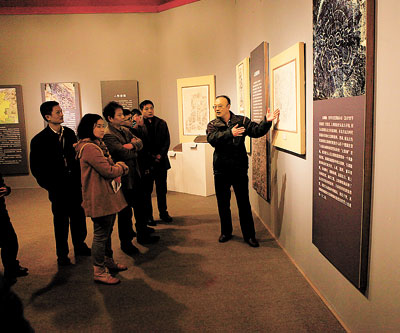|

Cao Zhen
caozhen0806@126.com
UNIQUE Ningxia petroglyphs, rock carvings dating back thousands of years, are on display at Shenzhen Museum on Tongxin Road, shedding light on the lives of prehistoric people of northwestern China.
The exhibits, including some 30 petroglyphs cut from rock, as well as 80 rubbings, feature images of human faces, figures, animals, symbols and deities. They were found in Dongshan Mountain and Helan Mountain from the Ningxia Hui Autonomous Region in Northwest China and are now housed by Ningxia Museum. Some ancient carving tools from Ningxia and pictures of petroglyphs from other countries are also displayed for comparison.
Ningxia, a scenic region of mountains, plateaus and deserts on the ancient Silk Road, was a main habitat for ancient nomadic peoples. The Yellow River runs through Ningxia from the southwest to the northeast and many rock carvings have been found on mountains along the river.
Most carvings on the Helan Mountain were found at Helankou, the dramatic gorge cutting northwest through the mountain ranges. The Helan Mountain acts as a boundary between the nomadic pastoralists to the north and the plain farmers to the south. As such, it has served as a meeting place for the peoples of the two lifestyles, marked by art carved on the rocks.
“By 2003, over 22,144 pieces of carvings have been found in Ningxia, showcasing the rich culture of various ancient ethnic groups,” said Li Tong, associate curator of Ningxia Museum. “Petroglyphs are a means of depicting everyday life and beliefs of prehistoric people from the days without literal characters. The carvings are made by gouging, incising, scratching and abrading.”
The petroglyphs appear to be simple pictures made up of lines and dots. A few of the more recent works contain mineral colors. Human figures portray scenes of hunting, dancing, herding, fighting or sacrificing, while the animal carvings depict tigers, goats, cattle, horses, deer and wolves.
“The carvings date from the Paleolithic Age to the Iron Age and their preservation on rocks is due to the sparse rainfall in the area, which ensures that erosion is minimal,” said Li.
The “Sun God” is the most famous of the Ningxia petroglyph images, which has bulging eyes and rays extending around the face. Li said the Sun God reflects prehistoric people’s worship of nature. Another ubiquitous image is the hand shape, meaning “power” or “possession” and symbolizing “commitment” or “order” conferred by the gods, according to Li.
While experts agree on the meanings of certain images, other symbols are still a mystery. Many researchers attach shamanic significance to the carvings, while others suggest less spiritual meaning and theorize they were just for recording daily events.
Petroglyphs have been found in more than 150 countries and regions across the world, and in other parts of China, including Inner Mongolia, Sichuan, Yunnan and Jiangsu. Unlike the Ningxia petroglyphs, which are representative of northern Chinese petroglyph styles and focus more on hunting and herding, those in southwestern China often depict religious activities. Those in southeastern coastal areas depict boats and fishing.
Dates: Until March 16
Hours: 9:30 a.m.-5:30 p.m. Closed Mondays
Venue: Shenzhen Museum, 6 Tongxin Road, Futian District (福田区同心路6号深圳博物馆老馆)
Metro: Luobao or Shekou Line, Grand Theater Station (大剧院站), Exit B
|

